The best soundbars for 2024: TV audio upgrades for all budgets
We've tested everything from elite Dolby Atmos soundbars to cheap and simple TV sound upgrades, and these are the best
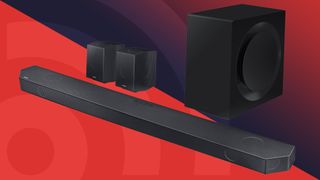
1. The list in brief
2. Best overall
3. Best budget
4. Best for Dolby Atmos
5. Best compact Atmos
6. Best for gaming
7. Best Sonos soundbar
8. Best for music
9. Best for flexibility
10. How to choose
11. Also consider
12. How we test
13. Latest updates
One of the best soundbars is essential if you’ve invested in a big TV and its speakers aren’t living up to its visuals. With one of the top soundbars, you get bigger, forward-facing speakers that deliver better speech clarity and immersion in movies. The best bit is they’re sleek and slim, often fitting below your TV on a cabinet or mounted on the wall.
Some TVs may not need a soundbar, but plenty of the best TVs you can buy today need an external soundbar for better audio – especially cheaper ones. Many of the best soundbars come in three styles: all-in-one units with just a single soundbar, soundbars with subwoofers, and soundbars with subwoofers and rear speakers for surround sound. The first is ideal for people who want a minimal setup, the second is great for big sound on a budget, and the third is perfect if you want a real home theater audio experience.
In expensive soundbars, you’ll find features like wireless connectivity, which can be used in multi-room speaker setups, while cheaper soundbars play the audio from your TV when linked via either an HDMI or optical digital connection. We’ve tested hundreds of soundbars and speaker systems over the years, including elite units with Dolby Atmos 3D sound, through to bargain soundbars that boost your sound.

Matt is TechRadar's Managing Editor for Entertainment, and has over a decade of experience in tech publishing. He has been writing about the latest TVs and soundbars since 2017. CES 2024 has been and gone, which gave us a glimpse of all the new soundbars on the horizon. Matt was most impressed by the announcement from Samsung about the HW-Q990D.
The quick list
In a hurry but need to find the best soundbar for you? Take a look at our quick list below which covers a soundbar that will suit every budget and situation. You can still check out more detailed reviews of each soundbar below.

The best soundbar for most people
The Q800C offers great cinematic sound, Dolby Atmos and DTS:X support at a great value price, making it the best buy for a lot of people.

The best budget soundbar
If you're looking to get immersive Dolby Atmos support on a budget, the Sony HT-S2000 is a no-brainer – a high-quality soundbar for a low price.
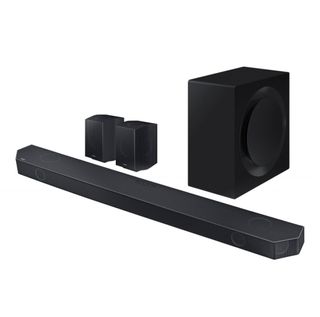
The best soundbar for Dolby Atmos surround
With outstanding power, range and impressive Dolby Atmos sound, the Samsung HW-Q990C is the best soundbar for the full Atmos experience.

The best soundbar for compact Dolby Atmos
If you're looking to get Atmos sound but are tight on space, this Bose is a soundbar that packs powerful sound into a small package.

The best soundbar for gamers
With two HDMI 2.1 ports, 4K 120Hz passthrough and VRR support, the HT-A7000 not only sounds great, but is the ideal choice for gamers

The best soundbar for Sonos fans
Sonos' soundbars are all excellent quality, but the Sonos Arc's dynamic sound, Dolby Atmos support and strong, built-in bass that puts it at the top of the Sonos family.
Load more products

The perfect small soundbar for music
Small in size but not in sound, the Sonos Beam's rich bass, level of clarity and hi-res audio compatibility make it perfect for music as well as movies.
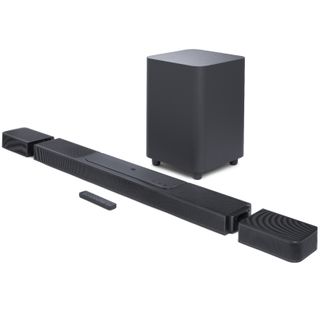
The best soundbar for sheer flexibility
With four HDMI ports to connect other sources and rechargeable, wireless surround speakers, the JBL 1300X really adapts to what you need.
The best soundbars of 2024
Why you can trust TechRadar
The best soundbar overall
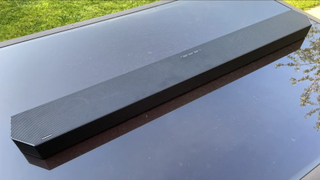
Specifications
Reasons to buy
Reasons to avoid
✅ You want the best value soundbar: The Q800C is a mid-range priced soundbar with premium features including excellent Dolby Atmos effects.
✅ You want a powerful sound: The Q800C offers punchy, direct sound with plenty of bass and brilliant clarity, especially when it comes to speech.
❌ You're after 4K 120Hz passthrough: If you have a next-gen console such as a PS5, you'll have to look at other soundbars for 4K 120Hz passthrough.
❌ You want the best soundbar for music: The Q800C has great sound quality but there are better soundbars for music such as the Sonos Beam at #7 in this list.
What you need to know: The Samsung HW-Q800C is a knockout when it comes to delivering a powerful, room-filling sound for a reasonably affordable price. With support for spatial audio formats like Dolby Atmos and DTS:X, it has an impressive soundstage thanks to two upfiring drivers that deliver exceptional height (those with a Samsung TV can also use its Q-Symphony tech). However, despite there being support for a variety of music files, including hi-res formats like FLAC, we don't think it's best suited for playing music – instead, look at the Sonos Beam (Gen 2) at #7 in this list. For everything else, it's a definite crowd pleaser.
Audio performance: When we heard the Q800C in action, the first thing we immediately noticed was its powerful sound, which made various spatial effects extremely convincing, especially for a soundbar that does not have rear speakers (although there is the option to add these to create even more immersive audio). It particularly shines when watching movies and TV shows thanks to excellent channel steering, deep bass and clear dialogue.
Design: In terms of looks, the HW-Q800C may not be the most visually appealing bar (it looks a lot like any other regular soundbar), but there is something particularly attractive about its grilled finish, which reminds us of an industrial aesthetic. Although it's heavy compared to to other soundbars, it's a reassuring heaviness that gives it that sense of quality. At 43-inches wide, it fits well exactly with a 50-inch TV and would look great with 55-inch plus sized TVs.
Value: This is an excellent value soundbar. It may not carry the same power and soundstage as the Samsung HW-Q900C, which is at #3 in this list, but it's a fraction of the price and the rear optional speakers will certainly add to the already fantastic 5.1.2 channels in the HW-Q800C itself. When you add all that together, it's no surprise why we think this is the best soundbar for most people.
Read our full Samsung HW-Q800C review
The best budget soundbar
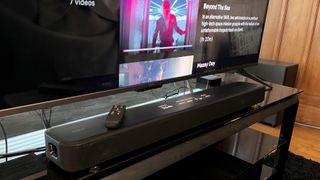
Specifications
Reasons to buy
Reasons to avoid
✅ You want an affordable soundbar: The Sony HT-S2000 launched with a higher price than the next cheapest offering at #7 in this list but is now regularly reduced for less.
✅ You want immersive sound: The HT-S2000 offers 3.1 channels of surprisingly powerful sound, with support for virtual Dolby Atmos, for a reasonable price.
❌ You own a next-gen console like a PS5: Without 4K 120Hz passthrough, the HT-S2000 isn't the best for gamers. Instead look at #5 in this list.
❌ You want a home audio system: The HT-S2000 does not have Wi-Fi so you won't be able to link it up to a multi-room wireless speaker system.
What you need to know: When it comes to sound quality and features vs price, we think the Sony HT-S2000 is the best budget choice around. Although it's a little basic in terms of connectivity, the sound you get from this soundbar is impressive for the money and is certainly a good choice for those looking for an upgrade to their TV sound without breaking the bank.
Audio performance: While the Sony HT-S2000's sound isn't the biggest, the sound you do get for your money is impressive. Clear dialogue levels and a spacious, virtual surround sound are two of the HT-S2000's highlights. Bass levels are also punchy enough, but it's the Sony HT-S2000's ability to reproduce Dolby Atmos effects that's surprising. It's not going to beat a soundbar with height channels, but for a 3.1 soundbar, it offers plenty.
Design: Design wise, the Sony HT-S2000 feels and looks more expensive than it is, with a solid, mesh metal grill on the front and a sturdy black plastic casing housing the speakers. The soundbar also produces visual feedback to remote control commands, something rare on budget soundbars.
Value: Yes, the HT-S2000 isn't going to set the world alight with its sound and certainly isn't the best soundbar for sound on this list, but when you're paying roughly $349 / £299 / AU$695 for a soundbar with this good a sound quality, it's hard to argue against.
Read our full Sony HT-S2000 review
The best soundbar for Dolby Atmos

Specifications
Reasons to buy
Reasons to avoid
✅ You want the ultimate home theater experience: With 16 speaker channels, the Samsung HW-Q990C is the most immersive soundbar on the market.
✅ You want to envelop yourself in immersive sound: The HW-Q990C comprises four components, giving you an extremely wide soundstage.
❌ You're on a budget: The Samsung HW-Q990C offers a lot of features but you'll have to pay a higher price for it than other Dolby Atmos soundbars like #4 in this list.
❌ You want the perfect bass response: The Q990C can have issues with bass reproduction when playing music, sometimes coming in too heavy.
What you need to know: The Samsung Q990C really is the best complete soundbar package around. With 11.1.4 channels split across the main bar, subwoofer and two compact rear speakers, the Q990C excels with Dolby Atmos playback and provides a powerful and immersive experience, be it movies or music.
Audio performance: Even when the Samsung Q990C is being pushed to its limits, it maintains an excellent quality sound without distorting. During our testing, we found that most trebles managed to stay clear and crisp even at higher volume levels. As for bass, the dedicated sub delivers a controlled sound that is deep and exciting (however, this struggles when playing music).
Design: The Q990C comes with four components that are a bit chunkier than previous iterations, so it does take up a sizeable portion of your living room. However, with access to Samsung's Q-Symphony technology, it's able to use the speakers in Samsung TVs to create an even bigger, bolder sound – which it succeeds in doing.
Value: However, with this amazing package comes a higher price tag. Prices continue to drop slowly since its release, but it still sits at the premium end of the market, hence why it doesn't top our list – instead look at the Bose Smart Soundbar 600 at #4 in this list for a cheaper Atmos alternative. But, if you are after the complete Dolby Atmos experience from your soundbar and you have a bigger budget, the Samsung Q990C is the absolute best choice.
Read our full Samsung HW-Q990C review
The best compact Atmos soundbar

Specifications
Reasons to buy
Reasons to avoid
✅ You want real Dolby Atmos: Unlike the Sony HT-S2000 at #2 in this list, the Bose Smart Soundbar 600 has two upfiring speakers to deliver true spatial audio.
✅ You're at the start of your home cinema journey: The Bose Smart Soundbar 600 has a load of wireless streaming options on board for multi-room listening.
❌ You want an all-in-one solution with bass: Without a sub, the Smart Soundbar 600 can lack oomph. Instead, look at #1 in this list for a complete setup.
❌ You have a complicated entertainment setup: The Bose Smart Soundbar 600 might have an HMDI eARC port but there's no second input for a console or disc player.
What you need to know: The Bose Smart Soundbar 600 is a fantastic choice if you’re looking for a budget soundbar that can really deliver. It pumps out big Dolby Atmos sound, but all from a relatively small package. In fact there’s a lots to love here, despite its size. Onboard streaming features, including AirPlay 2 and Chromecast, are plentiful, app-based setup is a breeze and the sound quality is surprisingly powerful.
Audio performance: In our review, we noted that dialogue clarity is excellent, and while it doesn’t hit the low bass notes that other soundbar systems with an included subwoofer manage, it offers up consistently exciting sound when watching movies and TV. Thanks to two upfiring speakers, you're also getting true immersive audio unlike some other budget bars.
Design: At 27 inches wide by 2 inches high and 4 inches deep, it’s a fairly sleek and compact design for an all-in-one unit and a perfect choice for smaller homes or screens. While it only has a single HDMI port, it makes up for this by packaging everything into an attractive all-in-one form.
Value: This soundbar impressed us in several ways during our testing, but its price is what really stood out to us as being excellent value. As one of the few soundbars that sell for under $500 / £500 / AU$700, it offers a lot more features than the likes of the Sony HT-S2000 at #3 in this list and Sonos Beam (Gen 2) at #7 in this list.
Read our full Bose Smart Soundbar 600 review
The best soundbar for gaming
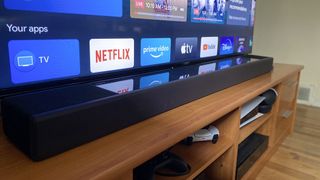
Specifications
Reasons to buy
Reasons to avoid
✅ You want to be able to hear dialogue: The Sony HT-A7000 offers clear and direct speech out of the box, no matter what source is put through it.
✅ You have multiple devices to hook up to your TV: The Sony HT-A7000 has two HDMI 2.1 ports for next-gen consoles that also support 4K 120Hz passthrough.
❌ You want full immersion: With limited height channels, the HT-A7000 falls behind other full surround sound soundbars like #3 in this list and #4 in this list.
❌ You want a full audio system: Despite its high price, a subwoofer and rear speakers still cost extra. But for just a little more, you can get a whole setup with #3 in this list.
What you need to know: You might be wondering how there can be a best soundbar for gaming? Well, it comes down to usability with extra devices. If you're a gamer and find yourself with both the PS5 and Xbox Series X, (on a large number of TVs) you will often find you only have two HDMI 2.1 ports. One of these will be dedicated to eARC, the HDMI audio channel, leaving you with just one HDMI port for both consoles if you want the full 4K 120Hz experience. What sets the Sony HT-A7000 apart from the rest here is that the two HDMI 2.1 ports offer passthrough at 4K 120Hz, which is perfect for gaming but, and support for VRR and ALLM to get the most out of the PS5 and Xbox Series X.
Audio performance: The HT-A7000 delivers excellent, clear dialogue that will suit any video game and movie that need the extra boost in clarity. It also features 360 Reality Audio music, which gives a room-filling sound when listening to music that's so surreal that it's as if you're standing in the middle of a concert.
Design: The Sony HT-A7000 is one of the few soundbars in this list to have an LED display, which – although is a nice touch in theory – is not as helpful as it looks. Instead, we found it difficult to tell which sound mode we were using when changing this using the display. It's also quite large, making it not suitable for TVs under 55-inches. If this is an issue for you, we'd suggest looking at a more compact option like the Bose at #4 in this list.
Value: Admittedly, with an optional subwoofer and rear speakers to purchase, the HT-A7000 does lose points on value, especially when the Samsung HW-Q990C at #3 in this list costs just a little bit extra to get a sub and rear speakers. But, in terms of gaming, the HT-A7000 covers gaming features better than any other soundbar in this guide.
Read our full Sony HT-A7000 review
The best Sonos soundbar
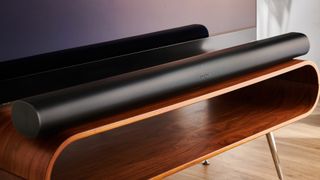
Specifications
Reasons to buy
Reasons to avoid
✅ You want the best Sonos soundbar: The Sonos Arc is more powerful than the Sonos Beam at #7 in this list and Sonos Ray, with great sound for both music and movies.
✅ You want an all-in-one soundbar: Like the Bose at #3 in this list, the Arc still gives great Atmos sound and strong bass, despite being a single unit.
❌ You want DTS/DTS:X support: The Sonos Arc only supports Dolby Atmos so any DTS audio tracks won't work. Alternatively, look to Sony's HT-AA700 at #5 in this list.
❌ You're putting your soundbar in front of your TV: The Sonos Arc is quite a tall soundbar so will obscure your view when placed directly in front of the TV.
What you need to know: The Sonos Arc isn't cheap, but if you're already a fan of Sonos then we think you're going to love the way this soundbar delivers really impressive Dolby Atmos sound. With stunning sound quality and a sleek design, it is one of the more attractive soundbars featured on this list.
Audio performance: The Sonos Arc draws on Dolby’s latest TrueHD and Dolby Digital Plus sound codecs to deliver the best quality lossless audio found on cutting-edge Blu-ray discs and some of the leading streaming services. Crucially, that also includes Dolby Atmos support, and while the reflected height and side channels aren't as pronounced as some of the soundbars here can manage, they're still impressive, and the range of precision of the Arc is superb.
Design: We're big fans of the look and feel of Sonos audio products. Alongside being simple to set up, this involved just a couple of steps on the smartphone app, the soundbar has minimalist cable connections and buttons on the bar itself. Its all-in-one system construction adds to this no-fuss feeling and streamlined aesthetic – though it's a real shame that there's no HDMI passthrough. Also, note that it's much taller than most Sonos soundbars so check whether it may be too tall for your TV before buying!
Value: Within the Sonos family, the Arc is undoubtedly top. Although the Sonos Ray and Sonos Beam (at #7 in this list) have their own strengths, the Sonos Arc has incredible soundscape contained within one bar that the other Sonos bars can't quite achieve. Although, as we said, you will need to pay extra for the Arc to get this quality difference.
Read our full Sonos Arc review
The best soundbar for music
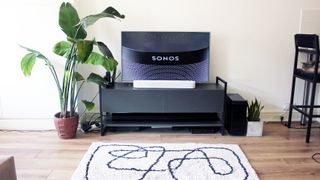
Specifications
Reasons to buy
Reasons to avoid
✅ You want a solid soundbar for music for less: At a mid-range price, the Sonos Beam Gen 2 offers fantastic music playback.
✅ You want an intuitive app: The Sonos app means that the Beam is not only easy to set up, but also easy to adjust settings and switch sources.
❌ You want a big surround sound: Being a standalone bar with no upfiring tweeters, the Beam's Atmos effects aren't very convincing.
❌ You have an Android device for Trueplay: The Beam could benefit from Trueplay to get its best sound, but it only works on iOS devices.
What you need to know: It may not be the biggest or most powerful soundbar, but in terms of audio performance, we found that the Sonos Beam (Gen 2) captures a balance that makes it perfect for listening to music. It is also compatible with hi-res audio files, meaning that through streaming sites such as Tidal, you'll get higher quality versions of your favorite songs played back through the Beam's impressive speakers.
Audio performance: During our testing of the Beam (Gen 2), we found the sound quality to be at its best when it came to music especially. When listening to Little Simz's Woman, we found that the bass sounded deep and controlled despite the lack of a dedicated subwoofer. This balance across bass and treble and clear vocals make the Beam ideal for getting the best out of your music.
Design: Like a lot of Sonos speakers, the Beam (Gen 2) follows a minimalist design aesthetic that we absolutely love. Like the Arc at #6 in this list, it is one of the more attractive soundbars. It is also compact, which means it can fit underneath most TVs, making it suitable for most living rooms.
Value: While you can hook the Beam (Gen 2) up to one of Sonos' subwoofers if you're looking for more bass in your music, the Beam's built in speakers provide a rich sound without it. This makes it an ideal choice for those who are looking for their soundbar to double as a speaker – and at a moderate price range, the Beam often outdoes its rivals in terms of musical performance.
Read our full Sonos Beam (Gen 2) review
The best soundbar for flexibility

Specifications
Reasons to buy
Reasons to avoid
✅ You need multiple HDMI ports: The JBL Bar 1300X comes with four HDMI ports so multiple devices can be connected.
✅ You want rear speakers with no wires: Supplied with wireless rechargeable speakers, there's no wires to keep things neat and tidy.
❌ You want to keep the rear speakers charged: The JBL Bar 1300X's rear speakers need regular recharging, unlike a more traditional setup like the HW-Q800C at #1 in this list.
❌ You want the cheapest soundbar: The JBL Bar 1300X is not budget-friendly, even compared to other soundbars in its price range.
What you need to know: The JBL Bar 1300X provides a fantastic level of flexibility. With Dolby Atmos and DTS:X support and a big, beefy sound aided by its larger than average subwoofer, its the connections and features packed into this soundbar that make it so versatile compared to other soundbars on the market. The one downside? This soundbar isn't going to suit serious gamers. While there are multiple HDMI ports here, none of them have 4K 120Hz pass-through to support that resolution and frame rate when playing games on PS5 or Xbox Series X, a feature you can find on our choice on the best soundbar for gaming, the Sony HT-A7000 at #5 in this list.
Audio performance: We think the JBL Bar 1300X would suit anyone looking for a powerful and immersive soundbar option, but particularly those who are after the visceral excitement that the best home theater systems effortlessly deliver, while also being relatively easy to setup and not becoming a burden on your living room.
Design: Although the JBL Bar 1300X doesn't take up too much space, it is designed to fill larger rooms with sound so we wouldn't recommend it in smaller homes. There are also multiple HDMI inputs here, meaning you can connect a stack of extra sources without worry, and the system’s rechargeable rear speakers can also be used as portable Bluetooth speakers. That might be a "so what?" feature for some people, but to us it's a design flex that heightens the Bar 1300X's overall value.
Value: Priced in line with the likes of the Samsung HW-Q800C at #1 in this list, the JBL Bar 1300X is not cheap but does deliver a lot flexibility to make up for it. From the rechargeable rear speakers that can also be used as bluetooth speakers and number of HDMI ports to the easy setup and immersive sound, this is one of the most flexible soundbars we've found. (Note: in some countries, you get the JBL Bar 1300 – without the X – which has a smaller 10-inch subwoofer driver instead of the 12-inch in the X version. This is a relatively small difference, and doesn't alter our overall opinion.)
Read our full JBL Bar 1300X review
How to choose the best soundbar
There are several things to consider when you’re looking for the best soundbar.
The first is the size. You’ll want to make sure that your soundbar fits under—or next to, depending on your set-up—your TV. For example, the long Sonos Arc soundbar is designed specifically for large screens, so won’t look right with a smaller 50-inch TV. You’ll need to know the size of your current TV and the size of the space you have to fit it and compare those figures to the dimensions listed alongside the soundbar you want to buy.
You’ll also want to consider whether you need a Dolby Atmos speaker or not. Dolby Atmos is surround sound technology, placing sounds and voices all around you so that whatever you’re watching or listening to is more immersive. The thing is, Dolby Atmos-enabled soundbars tend to be more expensive. You’ll need to weigh up whether Dolby Atmos sound is worth it for you. Otherwise, consider a capable but cheaper option, like the Yamaha SR-C30A, our choice for best cheap soundbar.
Another thing you’ll want to watch out for is the kind of connection you need. You’ll find most modern soundbars have HDMI connectivity, but there's also optical connectivity—so what's the difference? These are two ways that audio is passed from your TV to your soundbar, but HDMI passes high-resolution audio, including Dolby Atmos.
If you want a premium, immersive listening experience you’ll want to be sure you have an HDMI connection to use from your soundbar and an HDMI ARC (that's audio return channel) port on your TV for it to connect to.
But this means one of your TV's HDMI ports is used up by the soundbar, so some bars come with HDMI 'passthrough' ports, meaning you can connect a console/set-top box/etc to the soundbar, and it passes the visuals back to your TV. If your TV has few HDMI ports, you'll want a soundbar with this feature.
There’s more to think about, but getting the size, audio features and connectivity nailed down early on should make finding the best soundbar for you much easier.
What new soundbars were announced at CES 2024?
Out of all the new soundbar technologies we saw at CES 2024, Samsung's new HW-Q990D was by far our favorite. Its predecessor was our top recommendation for most people, but now that Samsung has fixed its only major flaw by adding 4K 120Hz pass-through to the HW-1990D's HDMI ports, we might have a strong contender to replace it. It's no wonder why we named it the best soundbar of CES 2024.
That wasn't the only new announcement Samsung had in store for us, with it also launching a Music Frame speaker called HW-LS60D, which we thought was both a great idea and a terrible one. The company says it's meant to "be used as a TV speaker, rear speaker, or a subwoofer" with the option to even pair two together for a more immersive soundstage. However, our biggest concern is its design. Given that it's meant to be hung on the wall, that could mean some distortion to the sound quality. Check back here when we've had the chance to review it.
As for LG, it had already announced information about its 2024 soundbar lineup ahead of CES 2024. Amongst a range of new soundbars, one interesting piece of information is that the LG S95TR and SG10TY pair wirelessly with compatible LG TV, via WOWCAST, and can even transmit lossless Dolby Atmos audio, according to LG.
But it wasn't just LG and Samsung that announced new soundbars. Klipsch also announced two new modular Dolby Atmos soundbars, which are more squarely aimed at the budget end of the market. The Flexus Core 100 is priced under $500, while the 200 is under $200, which means that you can comfortably take advantage of its wireless subwoofer compatibility to get a full 5.1.2 channel system for under $1,000.
What connection do I need for a soundbar?
The best way to connect a soundbar to your TV is with an HDMI cable. You'll need to make sure you have an HDMI port on your soundbar and an HDMI ARC port on your TV. This allows you to use a cable to connect them.
An HDMI port means that the highest quality audio can pass from your TV to your soundbar, like Dolby Atmos.
If your TV or soundbar doesn't have HDMI ports, the second best option is an optical. This can still transfer digital sounds, but not the high-resolution ones you'd get with HDMI.
However, you will still get quality audio and an optical connection does work with soundbars and surround sound systems.
What size soundbar should I get?
You need to get a soundbar that fits in the space you have available. Some people have their TV mounted and a soundbar could happily be mounted underneath. Others have their TV on a stand and the soundbar can sit in front of it.
Consider the space you have free but also the size of your TV. A compact soundbar might look silly with a massive screen and vice versa. There are many different-sized soundbars available to suit your TV, so make sure you check the dimensions and match them up.
Can soundbars do surround sound?
True surround sound means speakers are positioned around you. Some soundbars on this list, like the Samsung Q990C also come with a subwoofer and two smaller rear channel speakers, meaning you can place them around your room.
However, other devices with only one soundbar claim to offer surround sound. What this means is they deliver a stereo effect, which seems more like sound is coming from different directions, but isn't.
Many of the high-end soundbars in this list also have Dolby Atmos built-in. Again, this isn't technically surround sound, but the audio tech is advanced and creates the illusion of immersive sound by bouncing sounds off the walls and ceiling around you.
Are Dolby Atmos soundbars really worth it?
Although not all the soundbars on this list capture Dolby Atmos as well as a home theatre system, more and more soundbars are supporting Dolby Atmos, making it available to people with all budgets.
Yes, the level of detail you get from a full home theater system compared to soundbars with 'virtual' Atmos or surround soundbars isn't quite as high, Dolby Atmos soundbars are becoming more sophisticated and provide an extra level of immersion to your cinema experience.
Are soundbars worth it?
Absolutely. Even if you don't consider yourself a hardcore cinephile, the best soundbars make a world of difference to your TV watching experience—even the built-in speakers that come with the best TVs just don't do your favorite films, TV shows, and games justice.
How much should I spend on a soundbar?
It depends on what you're looking for. If you want the very best soundbar technology has to offer, you might be looking at prices of $800 / £800 / AU$1,000 and upwards.
However, there are lots of fantastic budget soundbars on the market, with some costing less than $100 / £100 / AU$150. Just bear in mind that you generally get what you pay for, and these budget models probably won't come with premium features like Dolby Atmos, included rear speakers, and hi-res audio support.
But, the mid-range market is getting more competitive and it really is easy to get a lot of bang for your buck, with soundbars (on our list above) providing Dolby Atmos and a subwoofer for under $400/£400/AU$650 becoming more and more common.
Where should I put a soundbar?
You generally have two options when it comes to soundbar placement: wall-mounting it, or placing in below your TV on your TV cabinet. If your soundbar is quite tall, wall-mounting may be the best option, as it could obscure the IR receiver on your TV, rendering your remote control useless.
Other soundbars to consider
We’ve reviewed several soundbars in 2023-24 that didn’t make this guide for various reasons, though they are also worth considering. On the budget soundbar front, there’s the Amazon Fire TV soundbar, which is frequently on sale for under $99 at Amazon’s site in the US. This is a very basic 2-channel model with HDMI eARC and optical digital ports plus DTS:Virtual X processing, though its sound quality is surprisingly decent for the price.
Another budget model is the Soundfun Mirai ($299), which like the Amazon soundbar is currently only available in the US. This soundbar is even more basic, with just optical digital and analog audio inputs. It’s also designed mainly to boost dialogue on TV shows and movies, and does that specific task very well.
Higher-priced soundbar options include the Bose Smart Ultra and Sennheiser Ambeo Soundbar Plus. Both are premium all-in-one models that deliver Dolby Atmos effects using actual upfiring drivers. Both are also pricey, with the Sennheiser in particular earning its keep with superior delivery of Atmos effects and extended bass. If the price of the Sennheiser Ambeo Soundbar Plus is too much for your budget, there’s the Sennheiser Ambeo Mini, a more compact and lower-cost model that provides a “big” sound, but doesn’t match the Plus when it comes to bass extension and Atmos height effects.
How we test the best soundbars
When we test the best soundbars, we look at categories such as audio performance, design, setup and usability, value for money and features - the same criteria we use for our reviews of soundbars.
After connecting the soundbar to a TV, we play not only streaming and 4K Blu-ray sources through the TV into the soundbar using the TV’s HDMI eARC connection (as 4K Blu-ray provides better audio quality than streaming), but also music over a Bluetooth wireless connection.
For audio performance, there are several factors we look at when testing. Soundbars are often used to upgrade a TV's built-in sound, so dialogue clarity and volume are key, as that’s where built-in TV speakers usually struggle the most. We also test bass, mids and trebles by listening to how each range sits within a mix, and also whether the soundstage is wide or narrow.
Dolby Atmos spatial audio and surround sound (both virtually and physically through extra speakers) have become common features on soundbars, so we will test the effectiveness and spaciousness of the surround sound, as some people will want a room-filling home theater feel without all the boxes needed for a full AV setup.
When it comes to higher-end soundbars, we expect 4K 120Hz passthrough on HDMI ports and will test that feature if available. Gamers specifically look for this feature as some TVs don’t have the four HDMI 2.1 ports needed to cover both games consoles and a soundbar.
Bluetooth streaming is more commonly being featured on soundbars as manufacturers look to offer an ‘all-in-one’ solution for movies and music. So, if a soundbar offers that feature, we’ll be sure to test its performance with streamed music. On more premium soundbars, we expect to see Wi-Fi streaming, although this is not always the case.
Setup and ease-of-use is another area we test, as some soundbars carry a plug-in-and-play philosophy whilst others require more in-depth calibration. More soundbars are featuring auto-calibration features to adjust the sound for the room they’re installed in, and this can make a big difference in sound quality. As part of our tests, we’ll listen to a soundbar before and after this calibration to see just how much of a difference it makes.
While we strive to maintain consistency in testing conditions, some of our writers have different setups they’ll be listening in. However, the tests carried out and the testing criteria are the same for all our reviews.
Latest updates
March 28, 2024
Added 'Other soundbars to consider' section with details on recently reviewed models not listed in the guide.
February 28, 2024
Added in a 'How we Test' section, explaining what tests we carry out on the soundbars that we add to this guide.
January 22, 2024
Updated product write-ups to summarise the key points of each review and added in more internal linking to related products to help you choose the right soundbar for you.
December 22, 2023
Added in 'buy it if' boxouts with quick pros and cons for each entry on the list.
November 14, 2023
Replaced the Samsung HW-Q700B with the Samsung HW-Q800C as 'best overall' due to stock levels. Replaced Sony HT-G700 with Sony HT-S2000 for 'best budget'. Deleted 'best mid-range Atmos' category.
Get daily insight, inspiration and deals in your inbox
Get the hottest deals available in your inbox plus news, reviews, opinion, analysis and more from the TechRadar team.

Matt is TechRadar's Managing Editor for Entertainment, meaning he's in charge of persuading our team of writers and reviewers to watch the latest TV shows and movies on gorgeous TVs and listen to fantastic speakers and headphones. It's a tough task, as you can imagine. Matt has over a decade of experience in tech publishing, and previously ran the TV & audio coverage for our colleagues at T3.com, and before that he edited T3 magazine. During his career, he's also contributed to places as varied as Creative Bloq, PC Gamer, PetsRadar, MacLife, and Edge. TV and movie nerdism is his speciality, and he goes to the cinema three times a week. He's always happy to explain the virtues of Dolby Vision over a drink, but he might need to use props, like he's explaining the offside rule.
- Michelle Rae UyContributor
